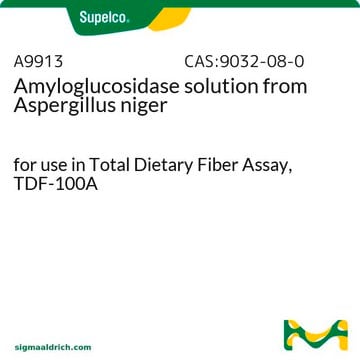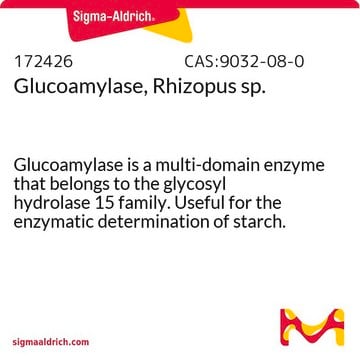A7095
Amyloglucosidase from Aspergillus niger
≥260 U/mL, aqueous solution
Synonym(s):
AMG 300L™, 1,4-α-D-Glucan glucohydrolase, Exo-1,4-α-glucosidase, Glucoamylase
Sign Into View Organizational & Contract Pricing
All Photos(1)
About This Item
CAS Number:
MDL number:
UNSPSC Code:
12352204
NACRES:
NA.54
Recommended Products
biological source
Aspergillus niger
form
aqueous solution
specific activity
≥260 U/mL
density
~1.2 g/mL at 25 °C
storage temp.
2-8°C
Looking for similar products? Visit Product Comparison Guide
Related Categories
General description
Stabilized with glucose.
Amyloglucosidase is a disaccharidase−type alpha-glucosidase, produced by several species of Aspergillus genus. Immobilization of amyloglucosidase is known to increased its stability.
Amyloglucosidase is a disaccharidase−type alpha-glucosidase, produced by several species of Aspergillus genus. Immobilization of amyloglucosidase is known to increased its stability.
Application
Amyloglucosidase from Aspergillus niger has been used in in vitro digestions. It has also been used in the isolation of insoluble and soluble dietary fibre from quinoa and amaranth.
Biochem/physiol Actions
Amyloglucosidase from Aspergillus niger is capable of hydrolyzing the α-D-(1-4), the α-D-(1-6), and the α-D-(1-3) glucosidic bonds of oligosaccharides. Amyloglucosidase is an extracellular enzyme that converts starch to dextrins and glucose. The enzyme is used in the starch-processing industry for the commercial production of D-glucose from corn syrups.
Other Notes
View more information on enzymes for complex carbohydrate analysis at www.sigma-aldrich.com/enzymeexplorer
Legal Information
A product of Novozymes Corp.
AMG is a trademark of Novozymes Corp.
Signal Word
Danger
Hazard Statements
Precautionary Statements
Hazard Classifications
Resp. Sens. 1
Storage Class Code
10 - Combustible liquids
WGK
WGK 3
Certificates of Analysis (COA)
Search for Certificates of Analysis (COA) by entering the products Lot/Batch Number. Lot and Batch Numbers can be found on a product’s label following the words ‘Lot’ or ‘Batch’.
Already Own This Product?
Find documentation for the products that you have recently purchased in the Document Library.
Customers Also Viewed
Quinoa (Chenopodium quinoa W.) and amaranth (Amaranthus caudatus L.) provide dietary fibres high in pectic substances and xyloglucans
Lamothe Lisa M, et al.
Food Chemistry, 167(4), 490-496 (2015)
Recent Advances in Basic and Applied Aspects of Industrial Catalysis, 891-891 (1998)
Fandila Carlos-Amaya et al.
Journal of agricultural and food chemistry, 59(4), 1376-1382 (2011-01-11)
Banana starch was chemically modified using single (esterification or cross-linking) and dual modification (esterification-cross-linking and cross-linking-esterification), with the objective to increase the slowly digestible starch (SDS) and resistant starch (RS) concentrations. Physicochemical properties and in vitro digestibility were analyzed. The
Changjiang Yu et al.
Biotechnology for biofuels, 10, 167-167 (2017-07-04)
Duckweed is considered a promising source of energy due to its high starch content and rapid growth rate. Starch accumulation in duckweed involves complex processes that depend on the balanced expression of genes controlled by various environmental and endogenous factors.
Biodiversity: New Leads for the Pharmaceutical and Agrochemical Industries, 12(5), 183-183 (2000)
Our team of scientists has experience in all areas of research including Life Science, Material Science, Chemical Synthesis, Chromatography, Analytical and many others.
Contact Technical Service










